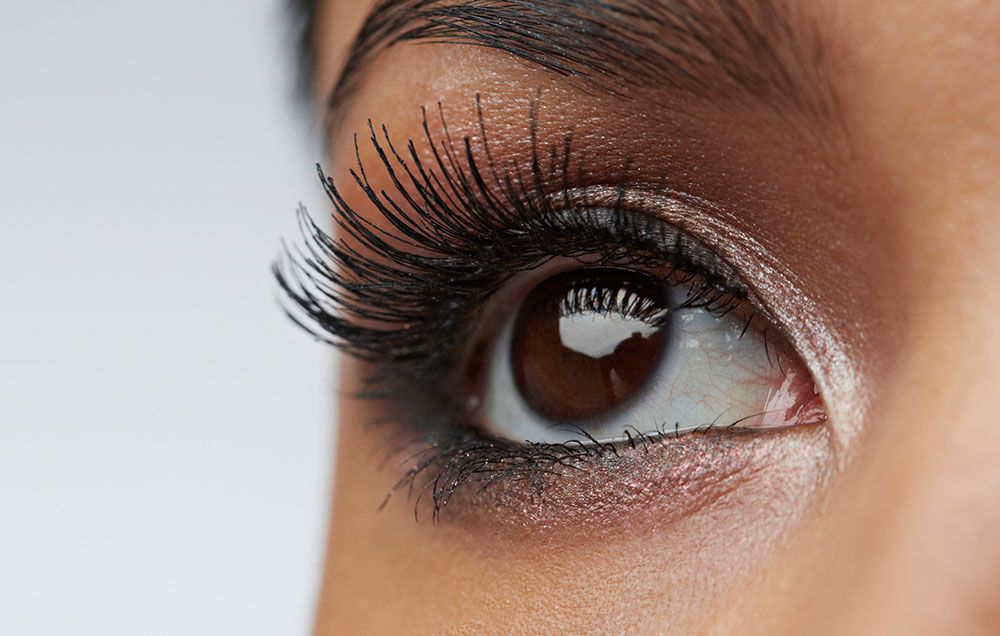Many women dream of having an expressive look; large, striking and striking eyes, either by following that standard of beauty or simply for pleasure and changing their physical appearance. To achieve this, many of the women undergo various alternatives available in the market, which are constantly changing, from the traditional such as makeup, to aesthetic trends such as eyelash extensions, eyelash lifts and treatments that promise to accelerate and / or increase its growth and volume. Each of these options has its advantages and disadvantages from the economic approach to the health implications,
Materials and techniques used for the implant of eyelashes
In ancient times, the increase in volume in the eyelashes was achieved from procedures or products made in an artisanal way, from cutting the end of each eyelash and thus promoting greater growth, to the use of ointments and cleanings to stimulate and achieve greater volume, this started the development of new techniques or inventions of materials evolving to what is currently available on the market [1].
There are different types of eyelash extensions: synthetic, silk, and mink.
The former being one of the least natural as they are thicker, firmer and brighter, it is recommended for women with healthy eyelashes because their thickness increases their weight, so it is suggested to use it only once.
Silk eyelash extensions are made of polybutylene terephthalate, a polymer that heats up and allows the eyelash to be molded with the desired curvature and size and also fixed when the material cools, they are the most desired by women due to their lightness and duration, however, in the scarce existing literature, no adverse events such as allergy to this material have been reported.
Finally, there are the mink eyelash extensions, which try to imitate a natural eyelash but are really still synthetic, with the difference that they do not allow themselves to be molded to create different curvatures, thicknesses and sizes.
On the other hand, at present, the eyelash extension technique is carried out with a special glue, Cyanoacrylate , which is a colorless, liquid, water-insoluble ether. The first medical uses of cyanoacrylate were in American soldiers during the Vietnam War, being used in sutures and containment of bleeding, it was administered in a spray and was very effective [2].
This component, when in contact with hot environments, releases gaseous elements that are harmful to the lungs and eyes [3].
Cyanoacrylate is the main component of eyelash glue, with other derivatives such as methyl-2 cyanoacrylate, which is designed to join two surfaces, in this case the eyelash extension and the natural eyelash [5].
Eyelash anatomy and life cycle
In humans, the hairy covering is present mainly on the skin, head, eyes and nostrils; it acts as a protector against environmental, physical and chemical agents [6]. In the case of the eyes, we find the eyelashes and eyebrows, which are terminal-type hair follicles. The terminal hairs of the eyelashes and eyebrows protect the eyes from dust, sweat and solar radiation; the eyelashes being the most pigmented hairs with the largest diameter in the entire body [7-8], these hairs are insensitive to androgens, which means that new eyelashes are not generated or their extension is changed by these hormonal factors [7 ].
The number of eyelashes that are arranged in the upper and lower lid margins are between 90 and 160 for the upper eyelid and approximately half for the lower eyelid about 75 and 80 lashes [9-10].
Eyelashes, like any other type of hair or follicle in the body, have a cycle of 3 phases: Anagen (growth lasting 1-2 months), Catagen (involution or rest lasting 15 days) and Telogen (loss ranging from 4-9 months) for a total cycle of 4 to 11 months, excluding the telogen phase in most eyelashes in order to maintain their collective protection mechanism [7-9]. This cycle is important to take into account when applying eyelash extensions because each follicle is going through an independent phase of growth, therefore it is recommended to carry out the relevant maintenance of the extensions in a period of no more than 2 months.
Adverse effects of eyelash extensions
As mentioned above, eyelash extensions are the adhesion of different materials to the base of the natural eyelashes; This adhesion is carried out through the use of adhesives derived from acrylates, which have been shown to be products with high formaldehyde emissions and from which the adverse effects at the ocular level are mainly derived [9-11].
There are several studies conducted on patients who have undergone this procedure in which it has been reported that the majority of patients experienced ocular side effects after the application of eyelash extensions that include itching, redness, pain and heavy eyelids [9-11 -12]. Likewise, other adverse effects associated with this procedure have been reported. For example, a study conducted in Ghana where 120 women were surveyed, of whom 97.5% had one or more of these symptoms; dry eyes 20%, itchy eyelids 30%, tearing 70%, burning sensation 55%, heavy eyelid 70%, eyelid edema and pain 20%, purulent discharge and eyelash loss 25% [13], which, when left untreated, lead to other more complex effects such as contact dermatitis ranging from mild to severe, toxic conjunctivitis, keratoconjunctivitis, conjunctival erosion and allergic blepharitis; which are mostly attributed to glue and the mechanical limitations implied by false eyelashes [11].
The allergic contact dermatitis is associated main effect is triggered from an inflammatory skin infiltrating cells, which carry a significant symptomatology such as erythema, papules, vesicles, edema, etc. [18-19] .
The sicca is directly related to the deficiency in the layers of the tear film, causing symptoms such as foreign body sensation, burning, photophobia , and decreased visual acuity [20].
With regard to toxic conjunctivitis , conjunctival erosion , and allergic blepharitis , recurrent signs and symptoms occur, such as itching mediated by immunoglobulin E release, pain due to cell dethithelialization or death, and mitogenic action (stimulation of cell division) without a release of antibodies that trigger a positive immune response due to exposure to air pollutants [19].
On the other hand, cyanoacrylate produces inflammation, tissue necrosis and granulation, by causing histological toxicity due to degradation products such as formaldehyde [2]. In 2007, the appearance of acute lymphoblastic leukemia was described in a 36-year-old Caucasian patient who resorted to the use of glue. To adhere the chipped tooth back into position, this procedure was performed for a consecutive year and in these attempts the patient reported glue on his gums that he cleaned with paper towels, although it cannot be concluded that the exposure to the chemical is directly related to the onset of the disease due to the scarcity of studies, unusual cases such as the one described above should be taken into account when using cyanoacrylate and its derivatives. [2-15].
It is also possible to find abrasions and ulcerations in the cornea , lesions that last longer to heal and the patient may report red eye, photophobia (sensitivity to light), tearing, foreign body sensation and will be treated with antibiotics and ocular lubricants.
In the same way, there are mechanical consequences that derive from false eyelashes, lagophthalmus during sleep is the main one, increasing exposure and corneal dryness; likewise, it promotes the accumulation of bacteria and microorganisms under the bed of the eyelashes, producing infections by these microbes [11]. Indeed, Demodex folliculorum, a parasite that lives in the hair follicle, the sebaceous glands and measures approximately 280 microns, is related to diseases such as rosacea , blepharitis , meibomitis and dry eye [14], all these consequences go hand in hand with the limitations to perform eyelid and eyelash cleaning of elements such as makeup or other agents that promote ocular infection [11].
Recommendations
Eyelash extensions should be limited to people with one of the following conditions: patients who have recently received or are currently receiving chemotherapy, people with alopecia or disorders such as trichotillomania; Likewise, those who have undergone lasik surgery should not use phoenix eyelash extensions during the 4 weeks after the surgical procedure. Furthermore, those with allergies to adhesive or latex are not suitable for the use of these [21].
Conclusions
There are various symptoms, pathologies and complications at the ocular level that can be triggered by the misuse of eyelash extensions, some of them with slight effects on vision and in turn simple treatment; and others that can significantly compromise the eye and general health of the person and whose treatment is more complex and depends mostly on the prompt consultation of the patient, such as chronic conjunctivitis, allergic contact dermatitis, blepharoconjunctivitis, keratoconjunctivitis where the corneal compromise goes further, producing corneal abrasions and ulcerations, among others.
One of the main factors that predispose to the development of complications after the implantation of eyelash extensions is the lack of information on the part of the users, either regarding the material of the eyelash itself, the glue used for adhesion, the appropriate size and thickness. or due practice in terms of posture technique, cleaning and changing or retouching them.
Eyelashes, like any other type of hair or follicle in the body, have a life cycle: anagen, catagen and telogen, its process lasts from 4 to 11 months. Taking this life cycle into account is of utmost importance for the change or maintenance of the extensions in order to maintain a physiological balance and an adequate process of the habitual replacement of natural eyelashes, thus avoiding their loss or permanent loss.
As a professional in the area of Optometry, you must have a basic knowledge about the adverse effects that the use of glue derived from acrylates brings, this in order to optimize the consultation and minimize the consequences that can significantly compromise eye health.
Ethyl-methylcyanoacrylate, the glue used to adhere false eyelashes, is harmful to humans since it degrades and generates toxins.
Acknowledgments . To Dr. Diana Rey, a teacher at El Bosque University for her style correction and motivation towards writing scientific texts.

